Michigan Graduate Students Design their Way Forward
How do you get 36 University of Michigan graduate students In departments ranging from music performance to business administration to spend 6 consecutive weeks together?
Food? No. Course credit? No. Life Design? Apparently.
After attending the inaugural Life Design Studio in June, Laura Schram, Director of Professional and Academic Development at Rackham, went straight to work. All good prototypes seek to answer a few questions -- they are mini experiments to learn - and Laura had a few questions in mind. For one, could doctoral students, in particular, feel more hopeful and confident about their future careers? Secondly, would any graduate students even want to participate in a longer term career development series if it wasn’t for credit? And, finally, would it “work” to have an extremely diverse group of students who don’t know each other talking about life together? Not all prototypes come back with positive results, but Michigan’s did. All the answers to Laura’s questions were yes.
Laura led a diverse group of students through 2 hours sessions that met once a week for 6 weeks consecutively. She focused heavily on life design prototyping. She emphasized networking so students could make contacts and have conversations to prototype their lives. And she really taught the power of a good brainstorming session with her students -- to come up with your best prototype ideas for your future you need many. She also used the Gallup Strengths assessment and strengths reinforcement activity from the Life Design Lab. For several consecutive years, Laura found that dozens of graduate and professional students gained confidence and hopefulness about their career prospects as a result of participating in the seminar.
When the pandemic hit and classes shifted fully virtual at the University of Michigan in 2020, Laura worried that she couldn’t navigate the shift to remote learning. Her Life Design Studio colleague at the Ross School of Business, Shahnaz Broucek, stepped in and reminded Laura that she need not be afraid of building a new prototype. Laura and Shahnaz co-designed and co-taught the virtual course with just as many students signing up as in previous years. They created more dedicated time and space for connection questions at the start of each class session to enable relationships to form despite the remote format, used pre-recorded asynchronous mini-lectures to reduce synchronous class time and tech exhaustion, and employed design tools like Mural to enable students to ideate together. Laura wondered, would she still find gains in student confidence and hopefulness from the start to the end of the class? The answer, even to her own surprise, was a resounding YES.
Michigan has confirmed what we consistently see in our graduate population at Stanford. Graduate students from MA to PhD, law to business, are hungry for this kind of life design conversation -- and at Michigan, it turns out, hungry enough to engage without external motivators.
Read Laura's take on the process in her article from Inside Higher Ed.
To learn more, contact Laura Schram at lnschram@umich

